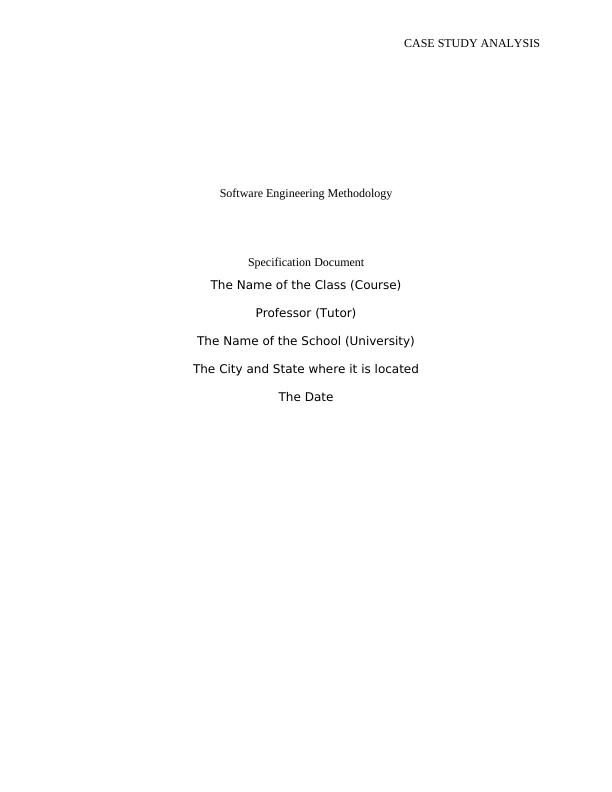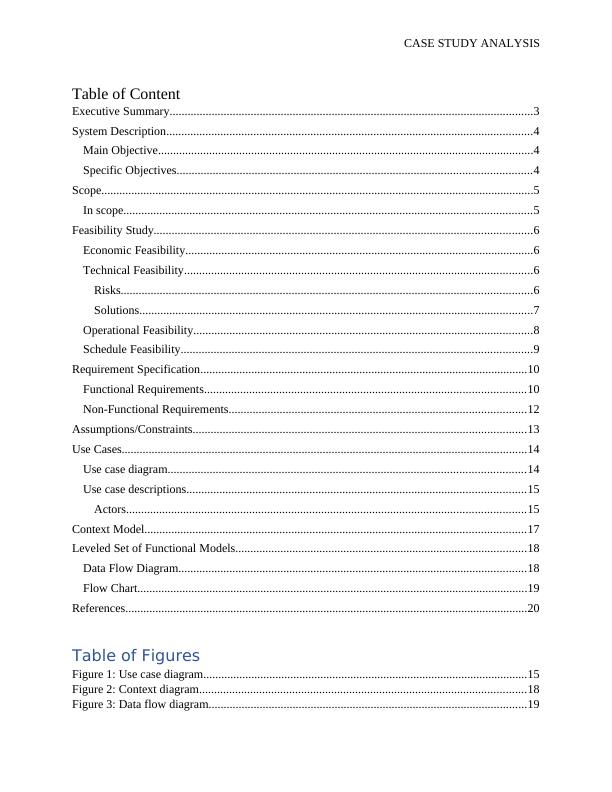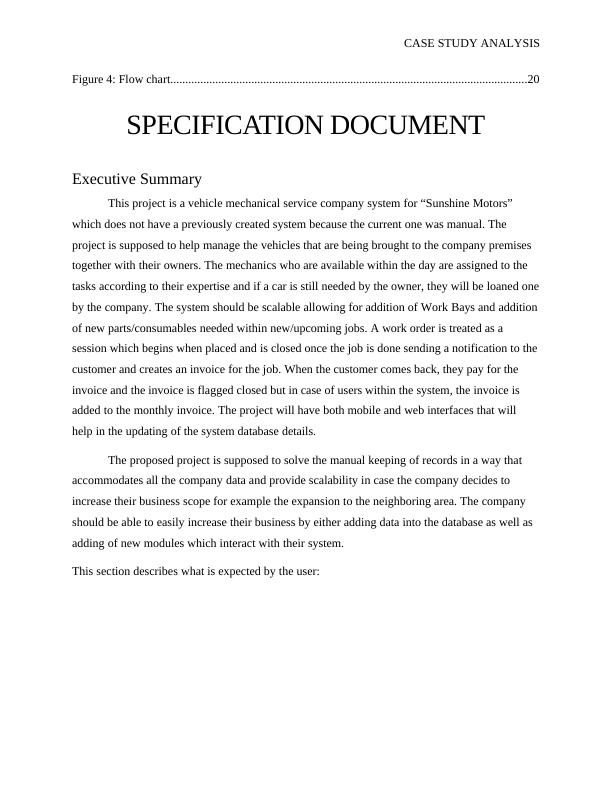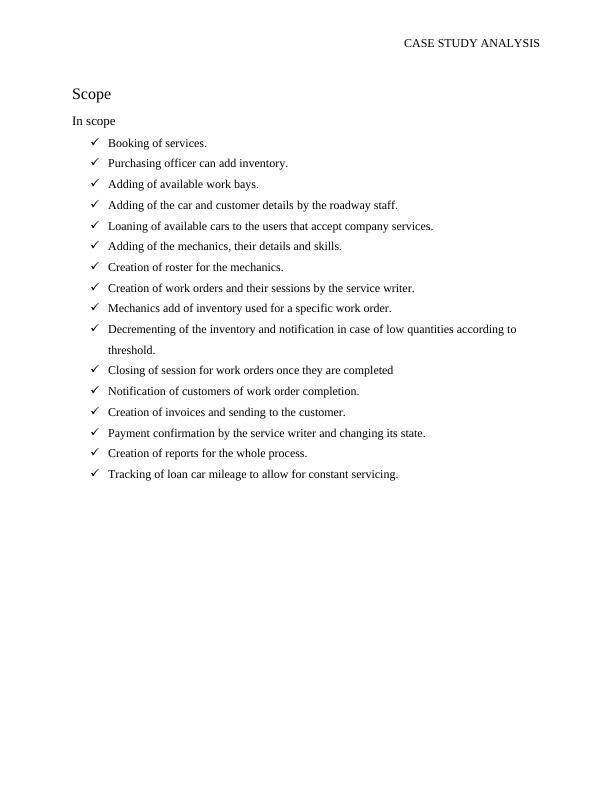Case Study Analysis: Software Engineering Methodology
Added on 2022-11-25
21 Pages3632 Words153 Views
CASE STUDY ANALYSIS
Software Engineering Methodology
Specification Document
The Name of the Class (Course)
Professor (Tutor)
The Name of the School (University)
The City and State where it is located
The Date
Software Engineering Methodology
Specification Document
The Name of the Class (Course)
Professor (Tutor)
The Name of the School (University)
The City and State where it is located
The Date

CASE STUDY ANALYSIS
Table of Content
Executive Summary.........................................................................................................................3
System Description..........................................................................................................................4
Main Objective.............................................................................................................................4
Specific Objectives......................................................................................................................4
Scope................................................................................................................................................5
In scope........................................................................................................................................5
Feasibility Study..............................................................................................................................6
Economic Feasibility....................................................................................................................6
Technical Feasibility....................................................................................................................6
Risks.........................................................................................................................................6
Solutions...................................................................................................................................7
Operational Feasibility.................................................................................................................8
Schedule Feasibility.....................................................................................................................9
Requirement Specification.............................................................................................................10
Functional Requirements...........................................................................................................10
Non-Functional Requirements...................................................................................................12
Assumptions/Constraints...............................................................................................................13
Use Cases.......................................................................................................................................14
Use case diagram.......................................................................................................................14
Use case descriptions.................................................................................................................15
Actors.....................................................................................................................................15
Context Model...............................................................................................................................17
Leveled Set of Functional Models.................................................................................................18
Data Flow Diagram....................................................................................................................18
Flow Chart..................................................................................................................................19
References......................................................................................................................................20
Table of Figures
Figure 1: Use case diagram............................................................................................................15
Figure 2: Context diagram.............................................................................................................18
Figure 3: Data flow diagram..........................................................................................................19
Table of Content
Executive Summary.........................................................................................................................3
System Description..........................................................................................................................4
Main Objective.............................................................................................................................4
Specific Objectives......................................................................................................................4
Scope................................................................................................................................................5
In scope........................................................................................................................................5
Feasibility Study..............................................................................................................................6
Economic Feasibility....................................................................................................................6
Technical Feasibility....................................................................................................................6
Risks.........................................................................................................................................6
Solutions...................................................................................................................................7
Operational Feasibility.................................................................................................................8
Schedule Feasibility.....................................................................................................................9
Requirement Specification.............................................................................................................10
Functional Requirements...........................................................................................................10
Non-Functional Requirements...................................................................................................12
Assumptions/Constraints...............................................................................................................13
Use Cases.......................................................................................................................................14
Use case diagram.......................................................................................................................14
Use case descriptions.................................................................................................................15
Actors.....................................................................................................................................15
Context Model...............................................................................................................................17
Leveled Set of Functional Models.................................................................................................18
Data Flow Diagram....................................................................................................................18
Flow Chart..................................................................................................................................19
References......................................................................................................................................20
Table of Figures
Figure 1: Use case diagram............................................................................................................15
Figure 2: Context diagram.............................................................................................................18
Figure 3: Data flow diagram..........................................................................................................19

CASE STUDY ANALYSIS
Figure 4: Flow chart.......................................................................................................................20
SPECIFICATION DOCUMENT
Executive Summary
This project is a vehicle mechanical service company system for “Sunshine Motors”
which does not have a previously created system because the current one was manual. The
project is supposed to help manage the vehicles that are being brought to the company premises
together with their owners. The mechanics who are available within the day are assigned to the
tasks according to their expertise and if a car is still needed by the owner, they will be loaned one
by the company. The system should be scalable allowing for addition of Work Bays and addition
of new parts/consumables needed within new/upcoming jobs. A work order is treated as a
session which begins when placed and is closed once the job is done sending a notification to the
customer and creates an invoice for the job. When the customer comes back, they pay for the
invoice and the invoice is flagged closed but in case of users within the system, the invoice is
added to the monthly invoice. The project will have both mobile and web interfaces that will
help in the updating of the system database details.
The proposed project is supposed to solve the manual keeping of records in a way that
accommodates all the company data and provide scalability in case the company decides to
increase their business scope for example the expansion to the neighboring area. The company
should be able to easily increase their business by either adding data into the database as well as
adding of new modules which interact with their system.
This section describes what is expected by the user:
Figure 4: Flow chart.......................................................................................................................20
SPECIFICATION DOCUMENT
Executive Summary
This project is a vehicle mechanical service company system for “Sunshine Motors”
which does not have a previously created system because the current one was manual. The
project is supposed to help manage the vehicles that are being brought to the company premises
together with their owners. The mechanics who are available within the day are assigned to the
tasks according to their expertise and if a car is still needed by the owner, they will be loaned one
by the company. The system should be scalable allowing for addition of Work Bays and addition
of new parts/consumables needed within new/upcoming jobs. A work order is treated as a
session which begins when placed and is closed once the job is done sending a notification to the
customer and creates an invoice for the job. When the customer comes back, they pay for the
invoice and the invoice is flagged closed but in case of users within the system, the invoice is
added to the monthly invoice. The project will have both mobile and web interfaces that will
help in the updating of the system database details.
The proposed project is supposed to solve the manual keeping of records in a way that
accommodates all the company data and provide scalability in case the company decides to
increase their business scope for example the expansion to the neighboring area. The company
should be able to easily increase their business by either adding data into the database as well as
adding of new modules which interact with their system.
This section describes what is expected by the user:

CASE STUDY ANALYSIS
System Description
The system is supposed to keep records for inventory of car parts used for fixing the cars
and also accept input about the cars being fixed and the customer details. Mechanics are
registered and put on a schedule and according to their skills. Work order jobs are to assigned
according to the mechanic’s specific skills. In case the job is done an invoice is created and sent
to the customer that has been created including both labor and the inventory that has been used
up. The payment is then made according to the invoice sent to the customer. In case the invoice
payment is not fully made the sales writer may set it to ‘pending’ or ask the customer is asked to
complete their payment. which may remain pending if the full payment is not made at the
moment.
Main Objective
The main objective of the system is to create a control system for Sunshine System
motors activities.
Specific Objectives
Incrementing and decrementing of inventory.
Inputting of car and customer details for car servicing.
Adding of mechanics.
Creation of various skills needed within the company.
Creation of work orders and their sessions.
Creation of a payment module for services.
Allowing for loaning of cars needed by customers.
Addition of work bays
System Description
The system is supposed to keep records for inventory of car parts used for fixing the cars
and also accept input about the cars being fixed and the customer details. Mechanics are
registered and put on a schedule and according to their skills. Work order jobs are to assigned
according to the mechanic’s specific skills. In case the job is done an invoice is created and sent
to the customer that has been created including both labor and the inventory that has been used
up. The payment is then made according to the invoice sent to the customer. In case the invoice
payment is not fully made the sales writer may set it to ‘pending’ or ask the customer is asked to
complete their payment. which may remain pending if the full payment is not made at the
moment.
Main Objective
The main objective of the system is to create a control system for Sunshine System
motors activities.
Specific Objectives
Incrementing and decrementing of inventory.
Inputting of car and customer details for car servicing.
Adding of mechanics.
Creation of various skills needed within the company.
Creation of work orders and their sessions.
Creation of a payment module for services.
Allowing for loaning of cars needed by customers.
Addition of work bays

CASE STUDY ANALYSIS
Scope
In scope
Booking of services.
Purchasing officer can add inventory.
Adding of available work bays.
Adding of the car and customer details by the roadway staff.
Loaning of available cars to the users that accept company services.
Adding of the mechanics, their details and skills.
Creation of roster for the mechanics.
Creation of work orders and their sessions by the service writer.
Mechanics add of inventory used for a specific work order.
Decrementing of the inventory and notification in case of low quantities according to
threshold.
Closing of session for work orders once they are completed
Notification of customers of work order completion.
Creation of invoices and sending to the customer.
Payment confirmation by the service writer and changing its state.
Creation of reports for the whole process.
Tracking of loan car mileage to allow for constant servicing.
Scope
In scope
Booking of services.
Purchasing officer can add inventory.
Adding of available work bays.
Adding of the car and customer details by the roadway staff.
Loaning of available cars to the users that accept company services.
Adding of the mechanics, their details and skills.
Creation of roster for the mechanics.
Creation of work orders and their sessions by the service writer.
Mechanics add of inventory used for a specific work order.
Decrementing of the inventory and notification in case of low quantities according to
threshold.
Closing of session for work orders once they are completed
Notification of customers of work order completion.
Creation of invoices and sending to the customer.
Payment confirmation by the service writer and changing its state.
Creation of reports for the whole process.
Tracking of loan car mileage to allow for constant servicing.

CASE STUDY ANALYSIS
Feasibility Study
In order to make sure the system will have a positive improvement within the business
compared to the previous manual system, the system pros are analyzed and weighed against the
cons. In case the pros are more than the cons or the disadvantages have minimum impact on the
business, the new system should be adopted or the previous system upgraded.
Economic Feasibility
Cost Benefit Analysis
The project will increase the cost benefits of the company. Previously, the tasks have
been stored within manual records. This led to financial tracking of transactions to become
hectic. Keeping records of the inventory used was manual. Tracking of the company records
sometimes would become hard leading to unforeseen losses. This led to the inability to keeping
of track of the used inventory therefore would have led to losses in case it was not updated.
Customers would therefore not use the company services in case they were impatient. The
accounting team was also unable to keep track of the monthly statements, processing of payment
and the reporting of the financial transactions.
The system will help enable the reporting of all the business transactions. In case the inventory is
used, the system will update the pricing in the work order which will be used in the invoice for
billing. This will improve the transaction speeds that will help in in keeping track of the
transactions.
Technical Feasibility
Risk assessment and solutions
Risks
o Failure to service the loan cars leading to failure as well as losses.
Risk Level: Low
o Failure to tracking of payment that has not been completed
Risk Level: High
o Failure to update/ purchase of the items that have been logged
Risk Level: Medium
Feasibility Study
In order to make sure the system will have a positive improvement within the business
compared to the previous manual system, the system pros are analyzed and weighed against the
cons. In case the pros are more than the cons or the disadvantages have minimum impact on the
business, the new system should be adopted or the previous system upgraded.
Economic Feasibility
Cost Benefit Analysis
The project will increase the cost benefits of the company. Previously, the tasks have
been stored within manual records. This led to financial tracking of transactions to become
hectic. Keeping records of the inventory used was manual. Tracking of the company records
sometimes would become hard leading to unforeseen losses. This led to the inability to keeping
of track of the used inventory therefore would have led to losses in case it was not updated.
Customers would therefore not use the company services in case they were impatient. The
accounting team was also unable to keep track of the monthly statements, processing of payment
and the reporting of the financial transactions.
The system will help enable the reporting of all the business transactions. In case the inventory is
used, the system will update the pricing in the work order which will be used in the invoice for
billing. This will improve the transaction speeds that will help in in keeping track of the
transactions.
Technical Feasibility
Risk assessment and solutions
Risks
o Failure to service the loan cars leading to failure as well as losses.
Risk Level: Low
o Failure to tracking of payment that has not been completed
Risk Level: High
o Failure to update/ purchase of the items that have been logged
Risk Level: Medium

End of preview
Want to access all the pages? Upload your documents or become a member.
Related Documents
Case Study Analysis: Software Engineering Methodologylg...
|18
|1253
|471
Table of Contents.lg...
|32
|3133
|59
Software Engineering and Methodologylg...
|18
|2871
|52
Specification and Design Document for Sunshine Motorslg...
|22
|2249
|20
Database in Software Engineerlg...
|27
|3556
|21
System and Design Document for Online Library Management Systemlg...
|21
|2836
|213
